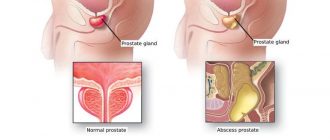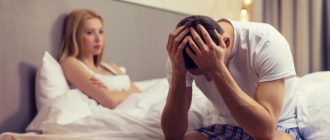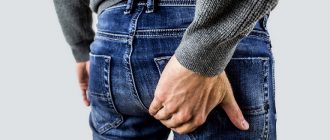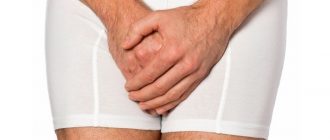Lower back pain with prostatitis is an uncommon symptom that usually occurs during chronic or long-term acute forms of inflammation. This is due to the fact that the prostate gland does not have nerve endings, but is connected to other parts of the body. Treatment should be approached with caution, because it is quite easy to cause serious harm.
Cause
With prostatitis, the lower back, back or other areas hurt because the organ is densely entwined with nerve endings leading to various parts of the body, but does not have them itself. As a result, when an inflammatory process or other pathologies occurs, pain radiates to other parts of the body.
The lumbosacral back is the most vulnerable part of the body during the spread of pathogenic processes, because it is connected to most organs.
The connection between prostatitis and the spine occurs when, when an inflammatory process occurs, the body begins to produce special neurotransmitters - prostaglandins, in large quantities. They are responsible for pain sensations, so the immune system points to the painful area. Prostaglandins enter the bloodstream and are localized in the diseased organ and adjacent tissues - this can be felt with prostatitis in men as pain in the back, lower back, perineum, testicles or anus.
Most often, this happens when the inflammatory process spreads to the external tissues of the prostate gland or involves adjacent organs. This occurs with a long development of the disease, not earlier than the 2nd stage (or later) of acute prostatitis, but is most often observed in the chronic form of the pathology. Therefore, if your back hurts with prostatitis, most likely the disease has been actively developing for some time, therapy has a weak effect, or medical recommendations are violated and the treatment is incorrect (not all prescribed medications are used or the regimen for taking them is violated). In the chronic course of the disease, this may indicate a period of exacerbation.
Features of pain
Pain in the back is not always associated with prostate diseases. Most often they indicate kidney pathologies or problems with nerve endings. To associate lumbar pain with the prostate gland, you should take a closer look at the presence of the following accompanying symptoms; their combination can quite accurately indicate pathologies of the prostate or genitourinary system:
- pain when urinating or having an erection;
- frequent urge to urinate, especially at night, weak stream, feeling of incomplete emptying of the bladder;
- presence of blood or pus in urine or semen;
- pain in the perineum or anus.
You can additionally associate back pain with diseases of the genitourinary system if you try to track the events or phenomena after which it occurs. Due to prostatitis, the lower back may hurt due to the following factors:
- after urination;
- during sexual intercourse or after ejaculation;
- after prolonged abstinence from sexual intercourse or vice versa – after a period of too intense sex;
- after local or general hypothermia or overheating of the body (bath, sauna or long-term hot bath);
- after physical activity or heavy lifting (especially cycling and horse riding);
- after driving a car for a long time (especially with a hard seat or poor road surface);
- after drinking alcohol or smoking;
- with frequent or prolonged stress.
Each of these factors can cause pain to appear or worsen. The feeling may radiate to the buttocks and perineum, as well as the upper back.
In addition, pain in the back can manifest itself in various ways:
- like a weak but constant aching or nagging pain. A specific area may not be explicitly felt;
- be sharp and strong, but short-lived. Pulsation and surges of pain are often felt, and sometimes a feeling similar to a cut may occur;
- acute spasms may be combined with static aching pain.
The nature of the pain can also suggest the characteristics of the course of the disease. Mild and constant pain occurs in the chronic form of prostatitis, strong and short-term pain occurs in the acute form.
With inflammation of the prostate, unpleasant feelings most often appear in the morning or at night.
Treatment
When back or lumbar pain occurs, the first thing you should do is provide the person with rest. It is highly recommended not to do the following:
- Without understanding the reason for “grabbing”, take antibiotics or other medications.
- Use various folk methods or remedies - herbs, heating, etc.
- Carry out massage or other manual procedures (they will be harmful if the pain is not associated with the prostate, but with the spine).
The correct actions would be the following:
- Visit the hospital and undergo a full diagnosis to identify the cause. Before this, it is better not to take anesthetics or antispasmodics - they will blur the clinical picture and complicate the diagnosis.
- If problems are identified specifically with the prostate gland, symptomatic treatment will only give a short-term effect. You should only take painkillers if you cannot bear the pain. The most important thing in treatment will be taking the right group of antibiotics, and this can only be detected after culture of prostate secretions.
- Consult your doctor and get recommendations on taking medications. For lumbar pain, the most commonly prescribed medications are: antispasmodics, non-steroidal anti-inflammatory drugs and muscle relaxants.
- If you experience frequent back pain, maintain a calm lifestyle as much as possible and temporarily give up intense exercise and sports.
- In addition to drug therapy for back problems, physiotherapeutic procedures can be prescribed - laser therapy, leeching, prostate massage, acupuncture, etc.



